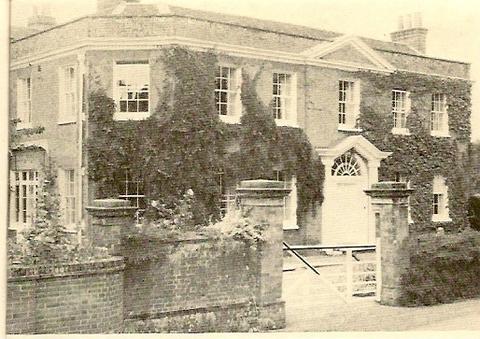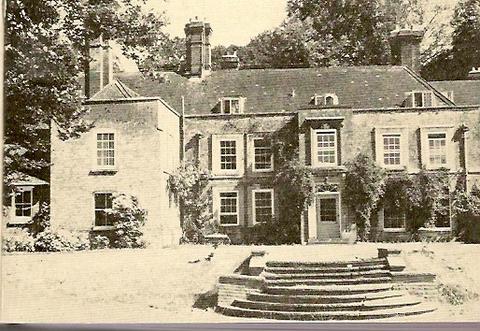Ellen and Jim Have a Blog, Too
We are two part-time academics. Ellen teaches in the English department and Jim in the IT program at George Mason University.


A _Critical Companion to Jane Austen_ contextualized · 17 June 08
Dear Friends,
About a week ago my review of William Baker’s Critical Companion to Jane Austen was published in the Eighteenth-Century Intelligencer. I’ve managed to put it on my site. My review is of wider interest since I situate the volume in the context of a history of recent semi-academic companions, dictionaries, and handbooks (the kind of thing meant for new, young, serious common readers and scholars of Austen). And I add four earlier illustrations, one comic Edwardian, one in the 1860s to 70s Victorian Idyllic style, and two from the earliest French translations of Austen’s texts; these anticipate key scenes in modern Austen films.
I put here for their historical interest and your delectation two of the photos included in F. B. Pinion’s older A Jane Austen Companion. They represent the sort of illustration he provides: these are pre-1950s photos of houses near Steventon which Jane Austen visited, perhaps even frequently:

Ashe House, the home of the Lefroys

Dean House, the home of the Harwoods
I fancy just such buildings were in Austen’s mind when she asks us to conjure up in our imagination Norland and Barton Park Houses in S&S, Longbourn owned by the Bennets in P&P, the Woodhouse home in Hartfield (Emma), or (in the case of Dean House) even Mansfield Park.
Ellen
--
Posted by: Ellen
* * *
Comment
- Someone has asked me if these houses are still standing or still look the way they do in these photos. I don’t know.
E.M.
— Elinor Jun 17, 2:48pm # - Thank you for the pictures, Ellen.
Do you know how rich were the Lefroys and the Harwoods so that we could make a closer comparison of them to Austen’s characters?
Sylwia
— Sylwia Jun 17, 5:24pm # - Dear Sylwia,
The short answer is, No, I don’t know the extent of their wealth or positions. The long answer is Tom Lefroy eventually rose to a very high position indeed, and one did not do that without money and strong connections, & it was at Dean House parties for the genteel nearby community were held. By contrast, the Steventon rectory had a slanting ceiling and exposed beams; neither Austen girl married, partly because there was no dowry; after he went bankrupt, Henry Austen ended a poor curate; Frances and Charles made good, but only by joining the navy at age 12; James took over the one (not very good) preferment Austen's father had managed to get.
Austen describes many different characters suggestively at different levels of power, gentility and fringe position. I don't think her fiction is that realistic to allow us to make these narrow kinds of comparisons. We are not given enough information about for example patronage, only told so-and-so had a lot of patronage (e.g., Darcy), but there the sense is of something almost fairy tale in its capacity. What we are given is a general sense of their rank and status, and then what is their precise income inside a milieu. There's a good brief essay on this in the new Oxford paperback edition of Sense and Sensibility, reissued 2008, by Vivien Jones (Appendix 1)
Ellen
— Elinor Jun 17, 11:39pm # - From Catriona Hall:
"That was a really informative review, thank you.
There are some interesting illustrations in the Steventon edition of the novels (Richard Bentley, London 1882), which, I think, is a reprint of an earlier edition with illustrations from early 1830s.
My preferred edition of Jane Austen’s novels is the OUP Illustrated, edited by RW Champman etc. but I am wondering about the new Cambridge edition, it seems very expensive, and I haven’t handled any of them. It would be fascinating to know what other interested readers think.”
— Elinor Jun 18, 9:08am # - From Clare:
“Thanks for posting the link to your review, Ellen. It was most useful, especially as you compared it to Pinion’s work, my yardstick.
You managed to indicate if the book was worth acquiring, something that is often missing from current reviews.
Clare”
— Elinor Jun 19, 8:51am # - From Kathy:
“I love your review of Baker’s Critical Companion to Jane Austen. Your commentary on other Austen companions and scholarship is also unusually interesting: the Pinion companion, which sounds similar to Baker’s, would be helpful to an amateur like me. Yes, the copy-editing is always a problem these days. Scholarship should be better-edited, but somehow typos sneak in.”
— Elinor Jun 19, 9:05am # - In response to Clare,
Pinion is good and he’s analogous to the Baker in what he does; but I’d recommend to others as central and perhaps more helpful than either: J.David Grey’s Jane Austen Handbook and E. Copeland and Juliet McMaster’s Cambridge Companion. If you want close reading, go to Baker; a general background account (very intelligent and well informed) Pinion, but for specific information, interpretive readings, groupings of the novels, milieu, and many other things too (about Janeism, money let’s say, cultural books of the era), the ones to go to are still Grey and the Cambridge.
Since I’ve come on let me also endorse the new Cambridge Companion to Burney. There’s a useful review article of the new Cambridge Companion to Fanny Burney in the most recent issue of the Eighteenth-Century Intelligencer, NS 22:2 (May 2008):39-43. It’s by Mascha Gemmecke. In the spirit of recent times (anti-feminism) Gemmecke presents herself as continually puzzled or objects to the thesis or spirit of a number of the articles in the volume. To read Fanny Burney is to read proto-feminism of the Austen kind you see and she seems not to admit she's recognized feminism or (when she does) treats it as invalid. Those who avoid feminism come in for praise.
However, Gemmecke does clearly tell what’s in the articles and makes it clear that the volume is really worth buying. Also a number of the authors are excellent writers and scholars (Margaret Anne Doody for example).
Ellen
— Elinor Jun 19, 10:56am #
commenting closed for this article
